Nazi Film & Propaganda
My research in this area of the project focuses on the utilization of animals with Nazi films adaptations of Brothers Grimm Tales to support an invested interest in the concept of a peasant society and romanticized imagery for the past. The Third Reich was fascinated with the peasantry and held the belief that they were the true holders for the future of their empire. Animals were not present in the orignal version of "Rumpelstiltzchen", but this film shows that they put in animals whenever they could to support their identity to the peasantry. For instance, the following pie chart and donut graph provide the number of times each animal was shown on screen. As can be seen from the data the "Chicken/Duck" and "Horse" quantities are identical. While horses are also used by members of the court, they were also utilized by blacksmiths and background animals during the film. Furthermore, pigs, cows, and sheep were portrayed to add to the ambiance and environment of the farmer motif. A theme that persisted through multiple films, literature, and propaganda.
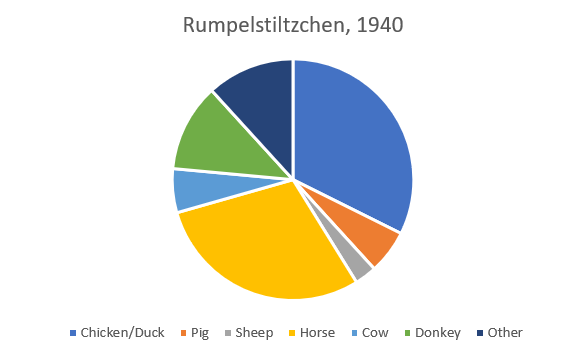
- Rumpelstiltzchen, 1940. Screen Shots of Animals.
- Märchen-Film Produktion Alfons Zengerling, "Rumpelstiltskin," directed by Alf Zengerling,October 3, 1940,
https://www.youtube.com/watch?v=VgUBgYMqdCk.
While there is a wide array of "Rumpelstiltskin" stories, the Nazis' film version bears striking similarities to the Brothers Grimm's original story. Only the beginning and the end are a bit different. For instance, in the film, the monarch and the miller meet when the king hurts his ankle in a forest close to the mill. After rescuing the king, the miller boasts in front of the nobleman - which he does not recognize as his king - that his daughter is able to spin gold out of straw. So, the king invites the daughter to his castle and forces her to spin gold. Another variation found in the film is that one of the king's ministers looks through the locked rooms keyhole and notices Rumpelstiltskin spinning the straw instead of the peasant woman and begs the king to get rid of girl due to the fact she is a witch. The king does not listen, and all three days of spinning straw are completed. Lastly, whereas in the original tale, the king finds the out the little man's name in the Grimms' version of the story, in the film it is a servant that eavesdrops on Rumpelstiltskin. Throughout the movie there are continual references to a peasant lifestyle, with pigs or chickens in the background, multiple trips to the miller's domicile, and a servant girl who is the queen's most trusted confidant and rescuer. Even in the end when Rumpelstiltskin is disappointed and angered that the queen guessed his name, he grants her one more wish. The queen wishes the grumpy old minister to vanish, so Rumpelstiltskin turns him into a donkey. The former peasant girl has triumphed over the noble-born minister. The rise of the miller's daughter to a queen who rules over those born of higher rank in the city fit with Hitler's vision of leadership. The peasant girl fulfilled her role as a folk hero, and became a person of power who could direct the masses.
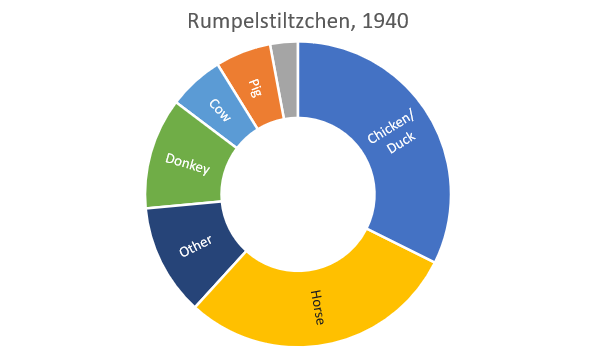
- Rumpelstiltzchen, 1940. Screen Shots of Animals.
- Märchen-Film Produktion Alfons Zengerling, "Rumpelstiltskin," directed by Alf Zengerling,October 3, 1940,
https://www.youtube.com/watch?v=VgUBgYMqdCk.
Similiar to "Rumpelstilzchen", "Die Sieben Raben" (The Seven Ravens) is an important tale within the Grimm canon. It is German stop motion-animated fairy tale released in Germany on December 2, 1937. The film is notable for being an animated feature film based on a Grimms' fairy tales story which premiered only a few weeks before Walt Disney's "Snow White and the Seven Dwarfs". In that respect it is often cited as one of the first animated feature films. In the original oral version, there were three, not seven ravens. The story unfolds as followed, a peasant has seven sons and no daughter. Finally a daughter is born, but is sickly. The father sends his sons to fetch water for her, in the German version to be baptized, in the Greek version to take water from a healing spring. In their haste, they drop the jug in the well. When they do not return, their father thinks that they have gone off to play and curses them and so they turn into ravens. She has no idea that she has older brothers until she is much older, and once she does she is determined to find them and have them return to the family. In the book she travels extensively while exploring a variety of regions (i.e. home of the sun, then the home of the moon, and lastly the home of the morning star), before she is given help and guidance to her brothers. However, in the film, instead of travelling she spends years in the forest. She is tasked by a "good witch" with silently spinning thread and making tunics for each of her brothers. If she can complete that task without talking and give each of her brothers one of the shirts they will turn back to human. While diligently working on the shirts she is accompanied by a variety of forest animals who help her pass the time and support her. The following graph displays the kinds of animals presented in the film and further shows how many shots each animal appeared in.
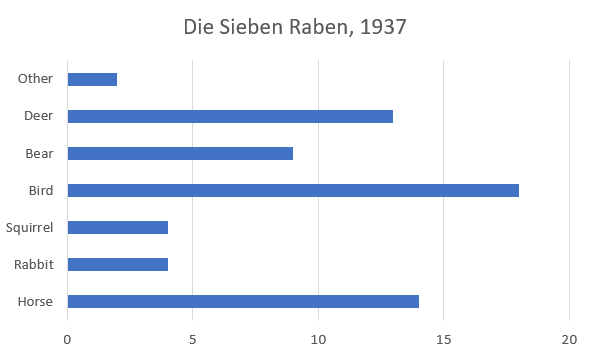
- The Seven Ravens, 1937. Screen Shots of Animals.
https://www.youtube.com/watch?v=bdt6FOePUv4.
According to Jack Zipes, the ability to use a spinning wheel and spindle was important to peasant women's marriageability. In order to be a suitable and marriable woman in the 1800s, one had to display their ability to spin wool and cotton into yarn. (Zipe, 53.) A woman's ability to spin wool during this time period proved to be helpful in providing clothing for the impoverished and helped supplement a small income for the family. Therefore, this skill was one of the essential necessities of a peasant woman and one of the main qualities for supporting a family. By focusing on the spinning of thread, the animal companionship, and her being the farmer's daughter by the middle of the tale the story begins to unfolds similiar to "Rumpelstiltzchen". She is found in the woods by a prince and is taken back to castle. After awhile they are wed and have a child. During this time she is still working on the shirts for her brothers and has remained silent. However, in one scene she is startled and makes a sound, making her baby turn into a raven. Resulting in her being accused of witchcraft. Nevertheless, the "good witch" takes the tunics she has completed and gives them to the brothers while she is being taken to a stake to be burned. The brothers become human again and rejoice, but the "good witch" hastens them to help their sister. The brothers race to the castle and are helped by a farmer and the eldest brother takes the horse and gallops to stop the burning. He reaches her just in time and she is save. The prince is overcome with joy, the brothers reunite with their sister, and the baby is changed back. All ending well, yet again, for the peasant's daughter. Who was raised by a rural family, taken in by the ruling nobility, and quickly becomes a queen.
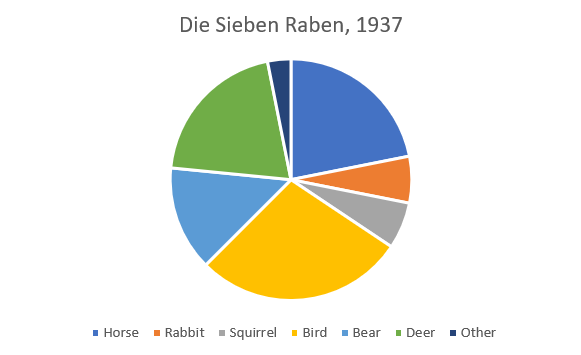
- The Seven Ravens, 1937. Screen Shots of Animals.
- Puppentrickfilm, “Die Sieben Raben,” directed by Ferdinand and Hermann Diehl, December 2, 1937,
https://www.youtube.com/watch?v=bdt6FOePUv4.
The Nazis believed that with diligence and fortitude the folk had nothing to worry about. By means of peasant virtues, disposition, character, and morality, the German Volk were assured a place in Nazi hierarchy and were expected to fulfill a role as folk heroes. The Nazi utilized stories such as the miller's daughter in "Rumpelstiltskin" to depict their heroes and to represent the superiority of the folk. Another way they represented the idealized folk was through advertisements, posters, and propaganda.
This image provides a visual representation of a peasant woman and farmer and strongly suggests the role they played in Nazi Germany. While the Nazis focused on Christian morals and patriarchal themes, they viewed the peasantry as key holders of these folk traditions. Central to Nazi ideology, the rural folk and countryside were important factors in safeguarding German nationalism and acted as buffers from foreign influence. Furthermore, the peasant was seen as the link to ancient German beliefs and customs - essentially folk heroes that preserved time honored traditions, and essentially the future of Nazism. Without the farmer utilizing the animal in the countryside background it would be hard to assume that this photo was about peasant life. Thus, the animal was integral to enforcing the peasant motif and German folk hero.
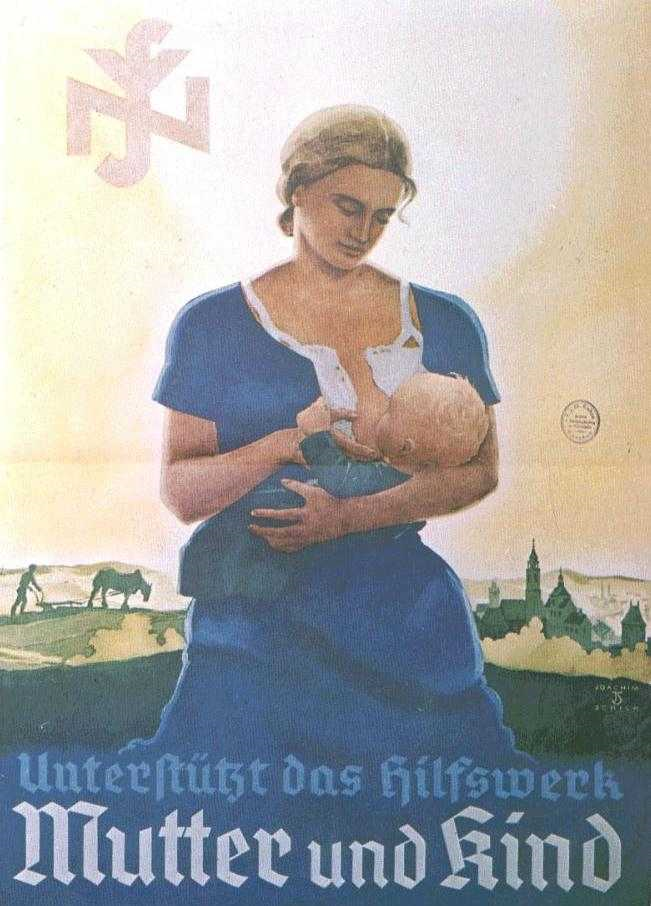
This poster probably dates to the mid-1930's.
It promotes the Nazi charitable organization (the NSV).
The text: "Support the assistance program for mothers and children."
To the Nazis, peasant life was quintessentially folkish, and peasants were the true carries of the völkische Bewegung (folkish movement). In Hitler's Mein Kampf (My Struggle) he states, "Preserving a healthy farming class is the cornerstone of the whole nation and can never be over-valued. Many of our current troubles result from the unsound relationship between country and city people. A solid nucleus of small and medium-scale peasant-farmers has always been the best protection against the kinds of social issues we have today." (Hitler, 90.) Hitler believed that a rural peasant of a village was more important and better than someone in a city. The Weltanschauung (worldview) of the Nazi party believed that traditional peasantry and rural life was the foundation of Nordic history and German folklore, and it would carry them into the future.
While stories such as "The Seven Ravens" and "Rumpelstiltskin" are still beloved and being modified for newer generations, their role during the Nazi regime cannot be understated. Fairy tales and folk tales are more than just articulated accounts or printed stories, they are "autobiographical ethnographies - that is, it is a people's own description of themselves." By inserting small changes into Grimm's fairy tales, the Nazis were able to inconspicuously tell their own story, and propagate their agenda in order to influence the masses. Far from simplistic children's stories, the Grimm's tales were powerful tools in the Nazi propaganda machine. As stated by Auden, in reference to the Brothers Grimm's tales, "…among the few indispensable, common-property books upon which Western culture can be founded - that is, excluding the national genius of specific peoples as exemplified by Shakespeare and Dante - it is hardly too much to say that these tales rank next to the Bible in importance." (Auden, 239-240.) In this adulation, the author expresses the deep connection that the Brothers had with the Anglo-American and European masses. With astute cunning, the Nazi's took advantage of this connection, snipping and cutting the materials to fit within their agenda.
All sources utilized can be found on the Sources Page.
